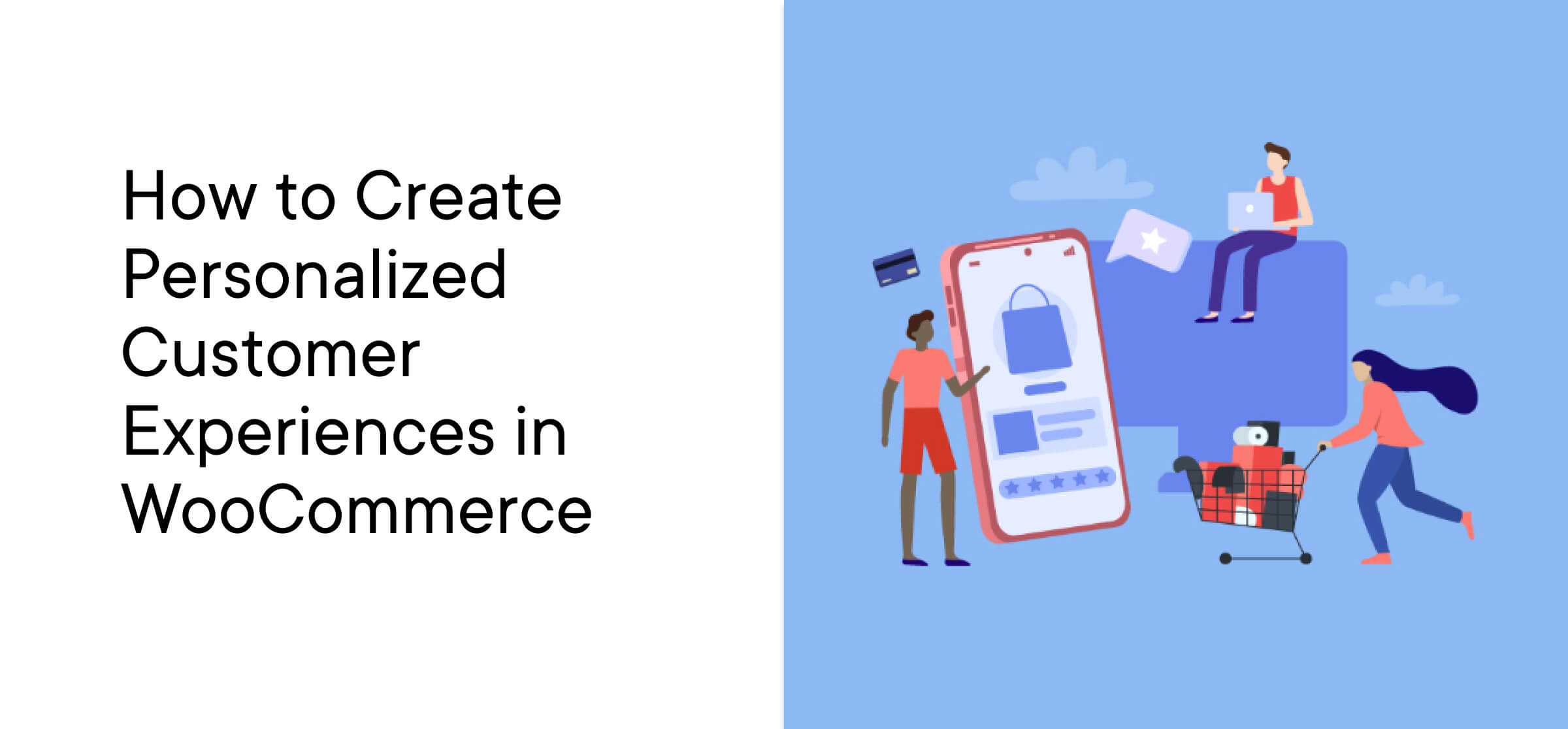What’s harder: winning the Masters Tournament or re-creating its website in under 30 minutes? Watch the video and find out.
WORDPRESS
How to Create Personalized Customer Experiences in WooCommerce

Are you looking to improve your eCommerce store’s customer satisfaction by offering personalized experiences? With the rise of online shopping, customers have come to expect high levels of personalization when browsing and purchasing products. In order to compete in today’s market, it’s crucial to offer a personalized experience for your customers. In this post, we’ll show you a few ways to personalize the customer experience within your WooCommerce store. From product recommendations to customized checkout pages, we’ll give you the tools you need to create a truly personalized customer experience.
What is Personalization?
Personalization in eCommerce refers to the practice of tailoring the customer’s experience to their individual needs and preferences. This can include things like product recommendations, customized messaging, and tailored promotions. The goal of personalization is to make the customer feel like the experience is tailored specifically for them rather than feeling like they’re just another customer.
The demand for personalization is high. A recent survey found that 60% of customers would not be loyal to a brand that delivered non-personalized content. Despite this high demand, only 35% of business managers are satisfied with their level of omnichannel personalization. This shows that while customers expect a high level of personalization, many businesses still have a way to go to give their customers the level of service they expect.
The Benefits of Personalized Customer Experiences
Personalizing the customer experience has a number of benefits, including:
- Increased sales: Personalized product recommendations and targeted promotions can lead to increased sales and revenue.
- Improved customer loyalty: Personalized experiences foster a deeper connection with the customer and can lead to increased customer loyalty.
- Enhanced customer satisfaction: Personalized experiences can make customers feel valued and appreciated, leading to higher levels of satisfaction.
- Better customer retention: Personalized experiences can lead to repeat customers and lower customer churn.
- More targeted marketing: Personalization allows for more targeted marketing efforts, leading to higher conversion rates and better ROI.
Overall, personalization can be a powerful tool for eCommerce businesses, it can lead to increased sales and revenue, improved customer loyalty, enhanced customer satisfaction, better customer retention, and more targeted marketing. With the right strategy and the right tools, you can create personalized experiences that will set your business apart from the competition and help you build long-term relationships with your customers.
How to Personalize the Customer Experience of your WooCommerce Store
Personalizing the customer experience on your WooCommerce store can seem like a daunting task, but with the right tools and strategies, it can be done. In this section, we’ll take you through some of the best ways to automate the customer journey and create personalized experiences for your customers.
Segment Your Audience

Audience segmentation is the process of dividing your customer base into smaller groups based on specific characteristics. Audience segmentation is an important step in creating personalized customer experiences. It allows you to understand your customer base better and create targeted marketing campaigns and personalized experiences that will resonate with them, ultimately leading to more sales and happier customers
By segmenting your audience, you can tailor your marketing efforts and customer experiences to specific groups of people. For example, you can segment your audience based on demographics, such as age, gender, or location. You can also segment your audience based on purchase history, such as what products they’ve bought or how often they’ve bought from your store. Once you’ve segmented your audience, you can use this information to offer more personalized customer experiences through targeted marketing campaigns such as email marketing, personalized product recommendations, and more.
Offer Fully Personalized Services
Offering fully personalized services is perhaps the most obvious way to create personalized customer experiences. Services that are tailored to each individual customer can provide highly personalized experiences that meet every customer’s unique needs.
For example, businesses such as therapy and personal training are, by nature, fully personalized services. Even if your business is a product-based one like SaaS, you can add on personalized services such as custom set-ups and 1-on-1 training. These services can create high levels of loyalty among your customers and open the door to affiliate marketing, which can help to grow your business without much time and money investment from yourself.
For SaaS businesses, personalized services such as onboarding, training, and support can help to increase customer satisfaction, retention, and lifetime value. Offering personalized services can also help to differentiate your business from the competition and create a more loyal customer base.
Customize Your Checkout

Getting your checkout experience right is crucial for getting customers to convert. Every customer is different, so your checkout needs to cater to each person’s needs.
To meet customer needs, you can customize your checkout in a number of ways. For example, you can allow customers to save their shipping and billing information for faster checkouts in the future. You can also offer multiple payment options, such as credit card, PayPal, and Apple Pay, to make checkout as seamless as possible.
Additionally, if you’re selling to international markets on WooCommerce, there are many customizations that you can make to make it inclusive to a worldwide audience. For example, it’s important that customers can select different currencies so they can choose the one that’s right for them so they can pay in their preferred currency and be protected from exchange rate fluctuations.
Personalize the Post-purchase Experience
Personalizing the post-purchase experience is crucial for maintaining customer satisfaction and building long-term customer loyalty. After a customer has completed a purchase, it’s important to continue to offer a personalized experience in order to keep them engaged with your brand.
One way to do this is through email marketing. By segmenting your email list and sending targeted, personalized emails to different groups of customers, you can ensure that each customer is receiving relevant content that speaks to their specific needs and interests.
Another way to personalize the post-purchase experience is by using personalized invoices. This is particularly useful for businesses that sell to other businesses (B2B) as it helps to keep track of orders more easily and provides customers with the supporting documents they need while filing their taxes. You can create personalized invoices using an invoice plugin or a print plugin, which allows you to easily create personalized invoices and print them automatically, individually or in bulk.
Finally, consider sending hand-written thank you notes to your customers. Studies have shown that customers who receive thank you notes spend more money with the business. While this approach is particularly effective for smaller businesses that have the capacity to produce these notes, you can also use a print plugin to create personalized notes that look like they are hand-written. This can help to create a more personal and intimate touch to the post-purchase experience, which can help to increase customer loyalty.
Personalization Creates Unforgettable Customer Experiences
Overall, personalizing the customer experience is essential to competing in today’s eCommerce market. Customers expect high levels of personalization and will lose loyalty if they don’t receive it. This article has shown you some of the best ways to automate the customer journey and personalize the experience on your WooCommerce store.
By segmenting your audience, offering fully personalized services, customizing your checkout, and personalizing the post-purchase experience, you can improve customer satisfaction and drive growth for your business.
Remember, personalization is not just about recommending products or sending targeted emails, it’s about understanding your customer’s needs and going the extra mile to meet them. With the right approach, you can create a loyal customer base that will keep coming back to your store time and time again.
WORDPRESS
[GET] The7 Website And Ecommerce Builder For WordPress
The7 website and ecommerce builder for wordpress is the most customizable WordPress, Elementor, and WooCommerce theme available on the market up to …
Source link
WORDPRESS
Making 43% of the Web More Dynamic with the WordPress Interactivity API – WordPress.com News

Creating rich, engaging, and interactive website experiences is a simple way to surprise, delight, and attract attention from website readers and users. Dynamic interactivity like instant search, form handling, and client-side “app-like” navigation where elements can persist across routes, all without a full page reload, can make the web a more efficient and interesting place for all.
But creating those experiences on WordPress hasn’t always been the easiest or most straightforward, often requiring complex JavaScript framework setup and maintenance.
Now, with the Interactivity API, WordPress developers have a standardized way for doing that, all built directly into core.
The Interactivity API started as an experimental plugin in early 2022, became an official proposal in March 2023, and was finally merged into WordPress core with the release of WordPress 6.5 on April 2, 2024. It provides an easier, standardized way for WordPress developers to create rich, interactive user experiences with their blocks on the front-end.
ELI5: The Interactivity API and the Image Block
Several core WordPress blocks, including the Query Loop, Image, and Search blocks, have already adopted the Interactivity API. The Image block, in particular, is a great way to show off the Interactivity API in action.
At its core, the Image blocks allow you to add an image to a post or page. When a user clicks on an image in a post or page, the Interactivity API launches a lightbox showing a high-resolution version of the image.
The rendering of the Image block is handled server-side. The client-side interactivity, handling resizing and opening the lightbox, is now done with the new API that comes bundled with WordPress. You can bind the client-side interactivity simply by adding the wp-on--click directive to the image element, referencing the showLightbox action in view.js.
You might say, “But I could easily do this with some JavaScript!” With the Interactivity API, the code is compact and declarative, and you get the context (local state) to handle the lightbox, resizing, side effects, and all of the other needed work here in the store object.
actions: {
showLightbox() {
const ctx = getContext();
// Bails out if the image has not loaded yet.
if ( ! ctx.imageRef?.complete ) {
return;
}
// Stores the positons of the scroll to fix it until the overlay is
// closed.
state.scrollTopReset = document.documentElement.scrollTop;
state.scrollLeftReset = document.documentElement.scrollLeft;
// Moves the information of the expaned image to the state.
ctx.currentSrc = ctx.imageRef.currentSrc;
imageRef = ctx.imageRef;
buttonRef = ctx.buttonRef;
state.currentImage = ctx;
state.overlayEnabled = true;
// Computes the styles of the overlay for the animation.
callbacks.setOverlayStyles();
},
...
The lower-level implementation details, like keeping the server and client side in sync, just work; developers no longer need to account for them.
This functionality is possible using vanilla JavaScript, by selecting the element via a query selector, reading data attributes, and manipulating the DOM. But it’s far less elegant, and up until now, there hasn’t been a standardized way in WordPress of handling interactive events like these.
With the Interactivity API, developers have a predictable way to provide interactivity to users on the front-end. You don’t have to worry about lower-level code for adding interactivity; it’s there in WordPress for you to start using today. Batteries are included.
How is the Interactivity API different from Alpine, React, or Vue?
Prior to merging the Interactivity API into WordPress core, developers would typically reach for a JavaScript framework to add dynamic features to the user-facing parts of their websites. This approach worked just fine, so why was there a need to standardize it?
At its core, the Interactivity API is a lightweight JavaScript library that standardizes the way developers can build interactive HTML elements on WordPress sites.
Mario Santos, a developer on the WordPress core team, wrote in the Interactivity API proposal that, “With a standard, WordPress can absorb the maximum amount of complexity from the developer because it will handle most of what’s needed to create an interactive block.”
The team saw that the gap between what’s possible and what’s practical grew as sites became more complex. The more complex a user experience developers wanted to build, the more blocks needed to interact with each other, and the more difficult it became to build and maintain sites. Developers would spend a lot of time making sure that the client-side and server-side code played nicely together.
For a large open-source project with several contributors, having an agreed-upon standard and native way of providing client-side interactivity speeds up development and greatly improves the developer experience.
Five goals shaped the core development team’s decisions as they built the API:
- Block-first and PHP-first: Prioritizing blocks for building sites and server side rendering for better SEO and performance. Combining the best for user and developer experience.
- Backward-compatible: Ensuring compatibility with both classic and block themes and optionally with other JavaScript frameworks, though it’s advised to use the API as the primary method. It also works with hooks and internationalization.
- Declarative and reactive: Using declarative code to define interactions, listening for changes in data, and updating only relevant parts of the DOM accordingly.
- Performant: Optimizing runtime performance to deliver a fast and lightweight user experience.
- Send less JavaScript: Reduce the overall amount of JavaScript being sent on the page by providing a common framework that blocks can reuse. So the more that blocks leverage the Interactivity API, the less JavaScript will be sent overall.
Other goals are on the horizon, including improvements to client-side navigation, as you can see in this PR.
Interactivity API vs. Alpine
The Interactivity API shares a few similarities to Alpine—a lightweight JavaScript library that allows developers to build interactions into their web projects, often used in WordPress and Laravel projects.
Similar to Alpine, the Interactivity API uses directives directly in HTML and both play nicely with PHP. Unlike Alpine, the Interactivity API is designed to seamlessly integrate with WordPress and support server-side rendering of its directives.
With the interactivity API, you can easily generate the view from the server in PHP, and then add client-side interactivity. This results in less duplication, and its support in WordPress core will lead to less architectural decisions currently required by developers.
So while Alpine and the Interactivity API share a broadly similar goal—making it easy for web developers to add interactive elements to a webpage—the Interactivity API is even more plug-and-play for WordPress developers.
Interactivity API vs. React and Vue
Many developers have opted for React when adding interactivity to WordPress sites because, in the modern web development stack, React is the go-to solution for declaratively handling DOM interactivity. This is familiar territory, and we’re used to using React and JSX when adding custom blocks for Gutenberg.
Loading React on the client side can be done, but it leaves you with many decisions: “How should I handle routing? How do I work with the context between PHP and React? What about server-side rendering?”
Part of the goal in developing the Interactivity API was the need to write as little as little JavaScript as possible, leaving the heavy lifting to PHP, and only shipping JavaScript when necessary.
The core team also saw issues with how these frameworks worked in conjunction with WordPress. Developers can use JavaScript frameworks like React and Vue to render a block on the front-end that they server-rendered in PHP, for example, but this requires logic duplication and risks exposure to issues with WordPress hooks.
For these reasons, among others, the core team preferred Preact—a smaller UI framework that requires less JavaScript to download and execute without sacrificing performance. Think of it like React with fewer calories.
Luis Herranz, a WordPress Core contributor from Automattic, outlines more details on Alpine vs the Interactivity API’s usage of Preact with a thin layer of directives on top of it in this comment on the original proposal.
Preact only loads if the page source contains an interactive block, meaning it is not loaded until it’s needed, aligning with the idea of shipping as little JavaScript as possible (and shipping no JavaScript as a default).
In the original Interactivity API proposal, you can see the run-down and comparison of several frameworks and why Preact was chosen over the others.
What does the new Interactivity API provide to WordPress developers?
In addition to providing a standardized way to render interactive elements client-side, the Interactivity API also provides developers with directives and a more straightforward way of creating a store object to handle state, side effects, and actions.
Directives
Directives, a special set of data attributes, allow you to extend HTML markup. You can share data between the server-side-rendered blocks and the client-side, bind values, add click events, and much more. The Interactivity API reference lists all the available directives.
These directives are typically added in the block’s render.php file, and they support all of the WordPress APIs, including actions, filters, and core translation APIs.
Here’s the render file of a sample block. Notice the click event (data-wp-on--click="actions.toggle"), and how we bind the value of the aria-expanded attributes via directives.
<div
<?php echo get_block_wrapper_attributes(); ?>
data-wp-interactive="create-block"
<?php echo wp_interactivity_data_wp_context( array( 'isOpen' => false ) ); ?>
data-wp-watch="callbacks.logIsOpen"
>
<button
data-wp-on--click="actions.toggle"
data-wp-bind--aria-expanded="context.isOpen"
aria-controls="<?php echo esc_attr( $unique_id ); ?>"
>
<?php esc_html_e( 'Toggle', 'my-interactive-block' ); ?>
</button>
<p
id="<?php echo esc_attr( $unique_id ); ?>"
data-wp-bind--hidden="!context.isOpen"
>
<?php
esc_html_e( 'My Interactive Block - hello from an interactive block!', 'my-interactive-block' );
?>
</p>
</div>
Do you need to dynamically update an element’s inner text? The Interactivity API allows you to use data-wp-text on an element, just like you can use v-text in Vue.
You can bind a value to a boolean or string using wp-bind– or hook up a click event by using data-wp-on–click on the element. This means you can write PHP and HTML and sprinkle in directives to add interactivity in a declarative way.
Handling state, side effects, and actions
The second stage of adding interactivity is to create a store, which is usually done in your view.js file. In the store, you’ll have access to the same context as in your render.php file.
In the store object, you define actions responding to user interactions. These actions can update the local context or global state, which then re-renders and updates the connected HTML element. You can also define side effects/callbacks, which are similar to actions, but they respond to state changes instead of direct user actions.
import { store, getContext } from '@wordpress/interactivity';
store( 'create-block', {
actions: {
toggle: () => {
const context = getContext();
context.isOpen = ! context.isOpen;
},
},
callbacks: {
logIsOpen: () => {
const { isOpen } = getContext();
// Log the value of `isOpen` each time it changes.
console.log( `Is open: ${ isOpen }` );
},
},
} );
Try it out for yourself
The Interactivity API is production-ready and already running on WordPress.com! With any WordPress.com plan, you’ll have access to the core blocks built on top of the Interactivity API.
If you want to build your own interactive blocks, you can scaffold an interactive block by running the below code in your terminal:
npx @wordpress/create-block@latest my-interactive-block --template @wordpress/create-block-interactive-template
This will give you an example interactive block, with directives and state handling set up.
You can then play around with this locally, using wp-env, using a staging site, or by uploading the plugin directly to your site running a plugin-eligible WordPress.com plan.
If you want a seamless experience between your local dev setup and your WordPress.com site, try using it with our new GitHub Deployments feature! Developing custom blocks is the perfect use case for this new tool.
The best way to learn something new is to start building. To kick things off, you may find the following resources a good starting point:
Join 106.9M other subscribers
WORDPRESS
The Masters Golf Tournament – WordPress.com News

Congratulations are in order for Scottie Scheffler, the winner of the 2024 Masters Tournament in Augusta, Georgia! In today’s Build and Beyond video, Jamie Marsland takes on the slightly less intimidating task of re-creating the Masters website as quickly as he can. Can he possibly do it in just 30 minutes?
Along the way, you’ll learn about sticky navigation menus, image overflows and breakouts, card layouts, and more.
Interested in a free trial that allows you to test our all that WordPress.com has to offer? Click below:
Join 110M other subscribers
-

 MARKETING6 days ago
MARKETING6 days agoRoundel Media Studio: What to Expect From Target’s New Self-Service Platform
-

 SEO6 days ago
SEO6 days agoGoogle Limits News Links In California Over Proposed ‘Link Tax’ Law
-
SEARCHENGINES6 days ago
Daily Search Forum Recap: April 12, 2024
-

 SEO5 days ago
SEO5 days ago10 Paid Search & PPC Planning Best Practices
-

 SEARCHENGINES5 days ago
SEARCHENGINES5 days agoGoogle Core Update Volatility, Helpful Content Update Gone, Dangerous Google Search Results & Google Ads Confusion
-

 SEO7 days ago
SEO7 days agoGoogle Unplugs “Notes on Search” Experiment
-

 MARKETING5 days ago
MARKETING5 days ago2 Ways to Take Back the Power in Your Business: Part 2
-

 PPC6 days ago
PPC6 days agoCritical Display Error in Brand Safety Metrics On Twitter/X Corrected













You must be logged in to post a comment Login